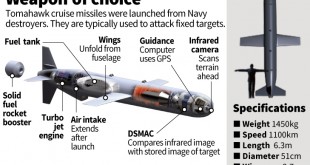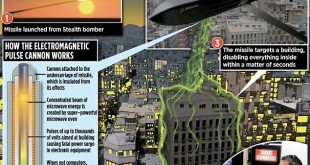Missiles are guided weapons designed to deliver a destructive payload to a target. They can be launched from various platforms, including aircraft, ships, and ground-based launchers. Some missiles are designed to hit stationary targets, while others are intended to engage moving targets, such as aircraft or cruise missiles.
One of the main challenges in intercepting maneuverable aerial targets is their ability to perform evasive maneuvers. Such targets can change their direction and altitude rapidly, making them difficult to track and hit with a missile. To overcome this challenge, modern missile systems often use advanced guidance systems that can adjust the missile’s trajectory in real-time to keep up with the target’s movements.
In recent years, there have been reports of advanced missile technologies being developed or deployed by various countries. Some of these technologies may incorporate advanced guidance systems that can enable the missile to “twist and tweak” in flight, allowing it to track and hit highly maneuverable targets.
The U.S. Air Force is exploring a novel concept for increasing the likelihood of scoring a hit in air-to-air combat. The idea is to use an air-to-air missile with a nose that bends to get at the target before it can get away. The service views this as one path to giving current and future combat aircraft, including a sixth-generation stealth jet being developed under the Next Generation Air Dominance program, a new way to engage increasingly maneuverable threats.
During the 2023 Air and Space Forces Association’s Warfare Symposium in Aurora, Colorado, the Air Force Research Laboratory showcased the Missile Utility Transformation via Articulated Nose Technology (MUTANT) project.
Missile Control Actuation Systems (CASs)
Missile Control Actuation Systems (CASs) are an essential component of modern missile systems. These systems are responsible for controlling the flight and trajectory of the missile during the launch and flight phases. CASs are typically composed of multiple subsystems, including sensors, processors, and actuators, which work together to ensure the missile reaches its intended target.
CASs use a combination of mechanical, electrical, and software components to control the movement of the missile. They receive input from various sensors, including accelerometers, gyroscopes, and guidance systems, to determine the missile’s position, speed, and orientation. This information is then processed by onboard computers, which use complex algorithms to calculate the optimal trajectory for the missile.
Actuators, such as motors or servos, are then used to adjust the missile’s fins or other control surfaces, which steer the missile in the desired direction. These adjustments can be made in real-time to correct for any deviations from the intended trajectory, such as wind or other environmental factors.
“A more effective missile tends to have more range, maneuverability (g-capability), and agility (airframe responsiveness) with limited weight. The missile control actuation systems (CASs) affects all three of these metrics, and hence the ability to effectively close in on targets,” AFRL’s webpage on MUTANT explains. “Each CAS, or CAS combination, such as dual canards and fins, have distinct and strong implications to overall missile performance.”
“CASs good for range (fins only) tend to be bad for maneuvering and agility,” it adds. “CASs good for maneuverability and agility (canards, wings, jets, thrust vectoring) tend to be bad for range due to drag or additional weight.”
Overall, CASs are critical components of modern missile systems, allowing them to navigate through complex environments and reach their intended targets with high accuracy.
AFRL’s Active Morphing and Articulation technology
AFRL aims to significantly increase missile range and lethality against highly maneuverable targets with a better flight control actuation system. The MUTANT program’s approach is a form of active morphing involving high-rate pivoting of the missile forebody, referred to as articulation
Active morphing involving high-rate pivoting of the missile forebody is a technology that allows missiles to change their shape during flight to enhance their agility and maneuverability. This technology is also known as “articulation,” and it enables the missile to pivot its forebody at high rates to change direction or perform other maneuvers quickly.
The traditional missile design typically has a fixed shape, with wings or fins that provide the necessary lift and control during flight. In contrast, an actively morphing missile can adjust its shape mid-flight to optimize its performance for a given task, such as engaging a highly maneuverable aerial target.
Articulation technology involves using motors or other actuators to pivot the missile’s forebody rapidly, allowing it to change its orientation and direction quickly. This capability provides the missile with enhanced agility, enabling it to make rapid adjustments and perform complex maneuvers that would be difficult or impossible for traditional, fixed-shape missiles.
Articulation is accomplished with an articulation control actuation system (ACAS), comprised of a composite high-strain skin structure that envelops an internal electromagnetic actuation system. With a single articulated joint, the missile forebody is used as a flight control surface to augment air-to-air axisymmetric missile effectiveness.
Many articulation ideas are outlined in patent literature, but they are not all plausible for supersonic missile environments. One promising approach involves rotating segments with canted interfaces. In concept, the action is similar to the F-35 Joint Strike Fighter vertical takeoff and landing swivel nozzle.
AFRL developed an electronically-controlled actuation system comprised of compact electromagnetic motors, bearings, gears and structures. Careful design allows a circular passthrough for component wiring into the aircraft body. A composite skin structure protects the actuation components from the environment while maintaining a smooth outer mold line (OML).
A homogeneous material may be most practical for the skin, but engineering requirements led to the a composite structure involving a metallic internal skeleton that is infilled with an elastomer. The combination of these materials, along with special design of the skeleton topology, allows smooth bending while still carrying a portion of the loads. Three skin concepts have been developed to various technology readiness levels with details given below.
US weapons technology advancement primarily involves fixed OML geometries that reflect a design compromise over the various stages of weapon delivery (e.g. launch, boost, cruise, terminal homing, end game). For example, what is aerodynamically good for range is not good for maneuverability. Morphing weapons technology allows continuous OML change to tailor performance to each phase of flight. Historically, size, weight and power of morphing technology has been prohibitive to a missile system level benefit. MUTANT is in the midst of tipping the scale in the morphing weapon’s favor.
Overall, active morphing and articulation technology represent a significant advancement in missile design, providing increased flexibility and maneuverability to missile systems, which can help them effectively engage highly maneuverable aerial targets and other challenging mission objectives.
AFRL advances ACAS technology readiness through laboratory and ground test events. From mid-fiscal year 2023 to the end of 2024, AFRL will perform three ground tests culminating in dual articulation and fin control in maneuvering a modified Hellfire missile. The Hellfire is used for research purposes and is not necessarily the intended application of the ACAS.
Overall, the development and deployment of advanced missile technologies represent an ongoing arms race between various countries.
References and Resources also include:
https://eurasiantimes.com/us-air-force-testing-mutant-missile-that-can-twist-tweak-strike-highly/
 International Defense Security & Technology Your trusted Source for News, Research and Analysis
International Defense Security & Technology Your trusted Source for News, Research and Analysis


